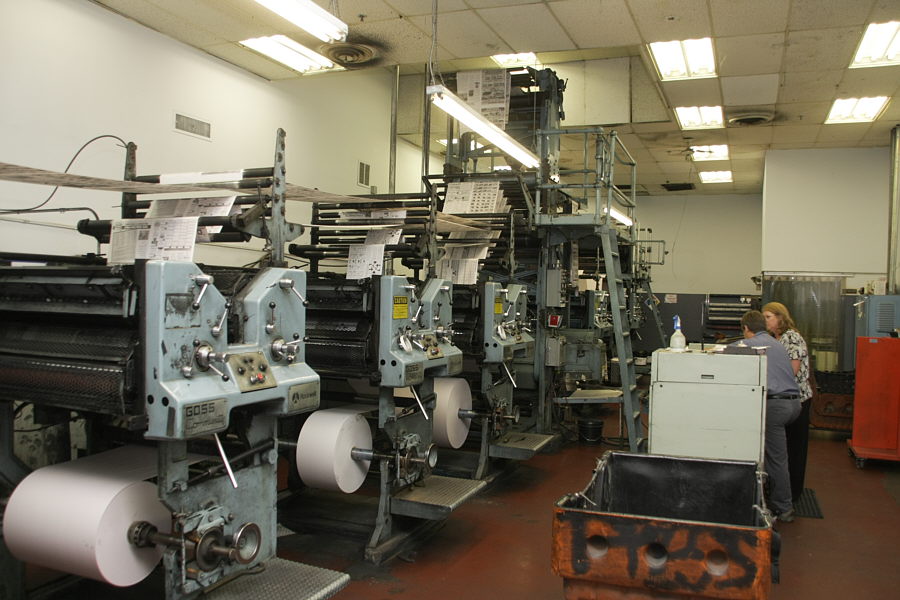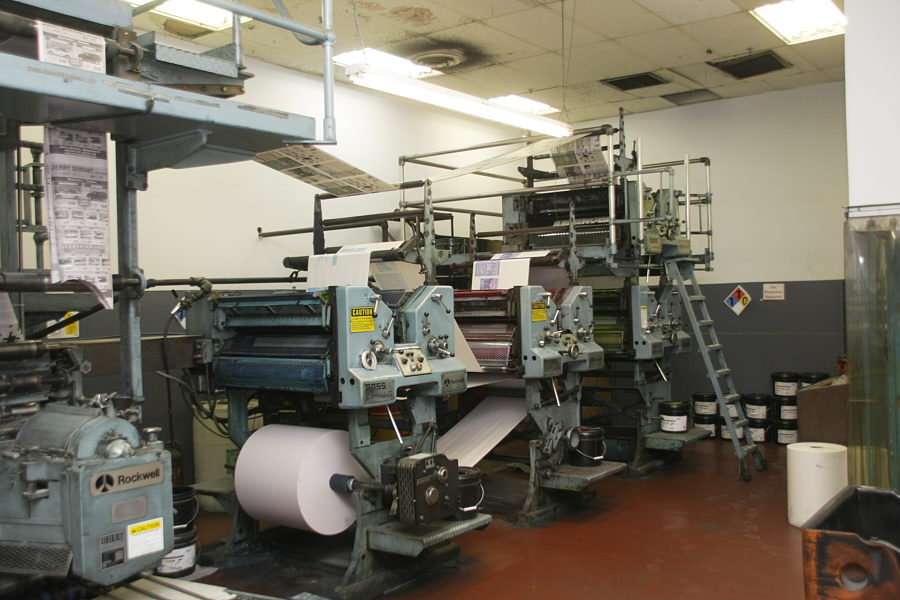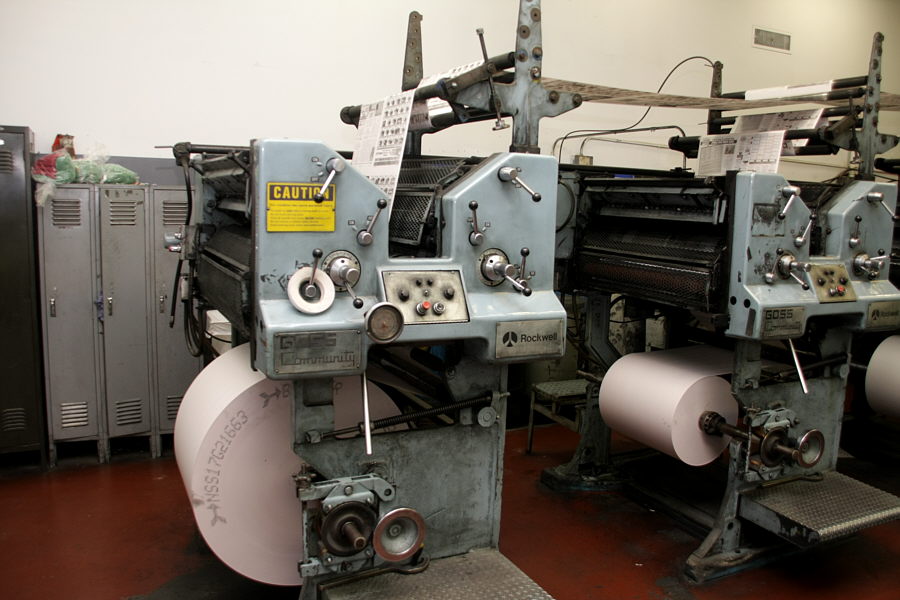Doug Kerr
Well-known member
Some wag once said, "Freedom of the press is only significant to someone who has one". Here, we report on a visit to somebody who does.
Our local daily newspaper is the Weatherford Democrat. Don't be misled by the name - it goes back to the time when (here in the South) the conservative political party was The Democratic Party. The paper leans a bit to the right (as befits the community), but not outrageously so.
The paper held a reception last Thursday for their new editor, a young woman born in this area who has been in the newspaper business almost all her life, most recently as Metro Editor for the Camden (N.J.) Courier-Post.
While Carla was discussing with her the need for enhanced coverage of local social and cultural activities, the publisher invited me to tour the printing plant.
The centerpiece is an 8-unit Goss Community-series web offset press, built in 1974 (when Goss was a division of Rockwell). It is set up to produce up to a 20-page edition with four pages in full color. Here we see the press from the "black end" (one unit is out of the frame to the left - we'll see it later).

Douglas A. Kerr: 8-unit Goss Community press - black end
The units are equipped for a "22.75" cutoff", meaning that the circumference of the plate and blanket drums is 22.75" and thus they produce a page 22.75" long (that is, high). The paper's page size is 11.00" wide, and the press units are thus fed with web stock 22.00" wide. (The 11.00" x 22.75" page size is very popular for papers today.)
The units each have two sets of plate and blanket cylinders, and print on both sides of the web. Thus (with the 22" web), each cycle produces four pages.
(This is called the "single-width" arrangement. Bigger papers, with larger presses, use a web four times as wide as the page. The web out of each unit is split lengthwise on the fly into two webs, which are then shifted into alignment as part of final assembly.)
We see that the second unit in this frame is fed with half-width web stock (11" wide). This produces a two-page sheet (you know, the ones you cuss when you are disassembling the daily paper to get paper to lay down on the patio floor when you are spray-painting the patio chairs). As you can see, the black end is producing four webs (including the half size one). Normally which will be accompanied by a full-color four-page web (produced on the other end of the press), for a total (for this particular setup) of 18 pages in the edition.
Here we see the color end of the press:

Douglas A. Kerr: 8-unit Goss Community press - color end
We see that two units are "stacked", forming a "tower".
The leftmost of the units does the "blue" (cyan) impression, the next unit the "red" (magenta), the bottom unit in the tower the yellow, and the top unit in the tower the black. (What we see here is left over from the run of an insert for the Sunday edition, and the pages are in fact laid out "crosswise".)
Note that the web here takes a roundabout route before actually entering the blue unit. This is to allow the paper to fully "relax" from its tensioned state on the roll before it enters the unit. If the relaxing were not complete by that point, it could lead to registration problems. Along the same line, the web supply spindle here is equipped with an electronically-controlled hydraulic tension brake to maintain the actual tension on the web constant as the roll diameter decreases. (A much more primitive tension brake is used on the units at the black end.)
On the left of the frame we partially see the folder, a Goss SC-series. The multiple webs are overlaid and then jointly creased down the center by turning down over the edges of a polished triangular "sail". A set of rollers flatten the resulting "gutter fold". Then the papers are sheared (22.75" long) and a second stage makes the final fold (the one we are so anxious to get our pix "above"). They come out on a set of conveyor bands overlapped ("shingled").
This folder also has a "quarter-fold" mode used for the special format with the pages laid out "crosswise" on the web (sometimes called the "tabloid" format).
Here we get a better look at one of the units on the black end (number 1, in fact, not seen before):

Douglas A. Kerr: 8-unit Goss Community press - unit 1
The "thermometer" dial just to the left of the red button is a tachometer showing the speed of the press. All the units at one end are driven by a large motor located near the folder, through a horizontal shaft behind the units (it is in a gray housing, and can be seen in the "color end" picture).
The paper rarely runs an edition of maximum size, and so often unit 1 is not used (maybe not 2 either).
I'm trying to arrange to go to the plant wile a run is being set up and started. I'm sure I'll learn a lot more then.
Sadly, the wonderful smell of an old-time press room has mostly disappeared owing to the more environmentally-friendly new ink recipes and the use of safer solvents than gasoline for cleaning!.
Perhaps soon this entire mode of information distribution will be extinct.
Best regards,
Doug
Our local daily newspaper is the Weatherford Democrat. Don't be misled by the name - it goes back to the time when (here in the South) the conservative political party was The Democratic Party. The paper leans a bit to the right (as befits the community), but not outrageously so.
The paper held a reception last Thursday for their new editor, a young woman born in this area who has been in the newspaper business almost all her life, most recently as Metro Editor for the Camden (N.J.) Courier-Post.
While Carla was discussing with her the need for enhanced coverage of local social and cultural activities, the publisher invited me to tour the printing plant.
The centerpiece is an 8-unit Goss Community-series web offset press, built in 1974 (when Goss was a division of Rockwell). It is set up to produce up to a 20-page edition with four pages in full color. Here we see the press from the "black end" (one unit is out of the frame to the left - we'll see it later).

Douglas A. Kerr: 8-unit Goss Community press - black end
The units are equipped for a "22.75" cutoff", meaning that the circumference of the plate and blanket drums is 22.75" and thus they produce a page 22.75" long (that is, high). The paper's page size is 11.00" wide, and the press units are thus fed with web stock 22.00" wide. (The 11.00" x 22.75" page size is very popular for papers today.)
The units each have two sets of plate and blanket cylinders, and print on both sides of the web. Thus (with the 22" web), each cycle produces four pages.
(This is called the "single-width" arrangement. Bigger papers, with larger presses, use a web four times as wide as the page. The web out of each unit is split lengthwise on the fly into two webs, which are then shifted into alignment as part of final assembly.)
We see that the second unit in this frame is fed with half-width web stock (11" wide). This produces a two-page sheet (you know, the ones you cuss when you are disassembling the daily paper to get paper to lay down on the patio floor when you are spray-painting the patio chairs). As you can see, the black end is producing four webs (including the half size one). Normally which will be accompanied by a full-color four-page web (produced on the other end of the press), for a total (for this particular setup) of 18 pages in the edition.
Here we see the color end of the press:

Douglas A. Kerr: 8-unit Goss Community press - color end
We see that two units are "stacked", forming a "tower".
The leftmost of the units does the "blue" (cyan) impression, the next unit the "red" (magenta), the bottom unit in the tower the yellow, and the top unit in the tower the black. (What we see here is left over from the run of an insert for the Sunday edition, and the pages are in fact laid out "crosswise".)
Note that the web here takes a roundabout route before actually entering the blue unit. This is to allow the paper to fully "relax" from its tensioned state on the roll before it enters the unit. If the relaxing were not complete by that point, it could lead to registration problems. Along the same line, the web supply spindle here is equipped with an electronically-controlled hydraulic tension brake to maintain the actual tension on the web constant as the roll diameter decreases. (A much more primitive tension brake is used on the units at the black end.)
On the left of the frame we partially see the folder, a Goss SC-series. The multiple webs are overlaid and then jointly creased down the center by turning down over the edges of a polished triangular "sail". A set of rollers flatten the resulting "gutter fold". Then the papers are sheared (22.75" long) and a second stage makes the final fold (the one we are so anxious to get our pix "above"). They come out on a set of conveyor bands overlapped ("shingled").
This folder also has a "quarter-fold" mode used for the special format with the pages laid out "crosswise" on the web (sometimes called the "tabloid" format).
Here we get a better look at one of the units on the black end (number 1, in fact, not seen before):

Douglas A. Kerr: 8-unit Goss Community press - unit 1
The "thermometer" dial just to the left of the red button is a tachometer showing the speed of the press. All the units at one end are driven by a large motor located near the folder, through a horizontal shaft behind the units (it is in a gray housing, and can be seen in the "color end" picture).
The paper rarely runs an edition of maximum size, and so often unit 1 is not used (maybe not 2 either).
I'm trying to arrange to go to the plant wile a run is being set up and started. I'm sure I'll learn a lot more then.
Sadly, the wonderful smell of an old-time press room has mostly disappeared owing to the more environmentally-friendly new ink recipes and the use of safer solvents than gasoline for cleaning!.
Perhaps soon this entire mode of information distribution will be extinct.
Best regards,
Doug
